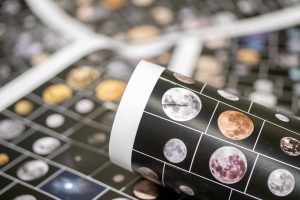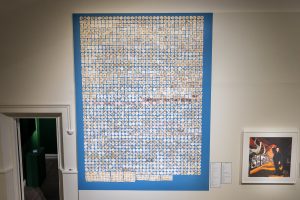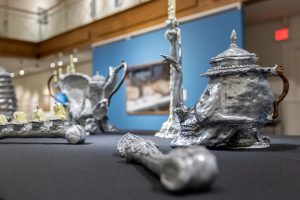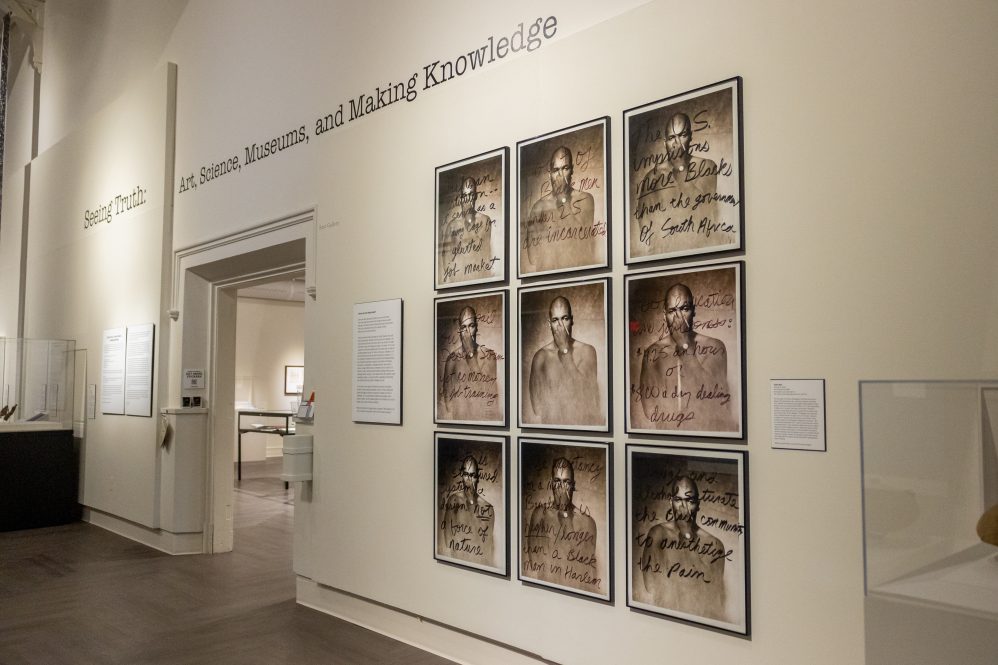When Alexis Boylan was young, she says she was drawn to the Choose Your Own Adventure series of books that allowed her to play a part in the story – to be a key player in each plot turn.
Those visiting her latest exhibition at the William Benton Museum of Art, “Seeing Truth: Art, Science, Museums, and Making Knowledge,” should expect the same experience – to be a participant in a show meant to question personal experience and collective history.
“This exhibition only holds together with the audience,” says Boylan. “My hope for this show is that you would be more of a participant, that you would make the meaning for this show as opposed to the curator telling you what to think. You might find some synergies between two pieces, but I’m not going to tell you about them.”

The show is part of the larger project, “The Future of Truth,” from UConn’s Humanities Institute, where Boylan is director of academic affairs. Over the last several years, “The Future of Truth” has included a series of events, conferences, and scholarly discussions on knowledge-making, creativity, and the very idea of truth.
Boylan, who also is a professor in the Africana Studies Institute and the art and art history department in the School of Fine Arts, says she and Humanities Institute Director and philosopher Michael Lynch sought to develop an ongoing discussion around the intangible when she returned from a research trip and they started talking about truth.
“It was in that energetic and vibrant conversation we decided that from our very different perspectives we were interested in having a conversation with the larger community about the future of truth,” Boylan says. “Where do we see truth going, should truth have a future, are there alternatives to truth that we should be investigating? Out of that came the larger umbrella project and later this exhibition.”
If “Seeing Truth,” which runs through March 10 and received support from the Henry Luce Foundation, has one thread tying it together, Boylan is succinct in summing it up: “Do we know things because we see them, or do we see things because we know them?”
She says she intended for people to walk through the exhibition struggling to see the connection between various objects, for instance Toshio Asaeda’s watercolor “Parrot Fish Scaridae and other Coral Reef Fish” and a diorama of polar bears on loan from the American Museum of Natural History.
“Maybe some of the things won’t connect, and that’s OK because museums don’t have to present a cohesive story. The audience can add their information and include their own knowledge, so they make their own connections,” she says.

Maria Patricia Tinajero’s wall sculpture “Body Journal” might be one of the most thought-provoking in the show – or at least the largest.
With more than 1,500 cotton pads arranged almost symmetrically, the installation showcases the different shades of color Tinajero wiped from her face at the end of each day over a decade. Makeup, sweat, and environmental grime tinge the swabs shades of beige, brown, pink, and tan.
“That’s a dataset,” Boylan says, explaining that she recently brought in a class of students and several in the group didn’t know that cotton pads are used for taking off makeup. That seemingly obvious detail was privy to only some in the group, “only certain people had access to understanding what that was.”
She also notes that cotton swabs are meant to be disposable after they’re used.
“But why are they not more or less interesting than any of the other datasets we collect, the samples we have that tell us how people live, what our day is like,” she asks. “I have no doubt there’s probably an anthropologist or biologist somewhere who would be very interested. It’s skin cells, it’s chemicals, it’s air samples. People who study fossils do more with less when you think about it.”
Boylan has included a pair of crampons used by explorer Lincoln Ellsworth during one of his four expeditions to Antarctica, on loan from the American Museum of Natural History, because on its face, the act of exploring is thought of as a heroic pursuit of knowledge. But that discovery often comes at the expense of people, or a landscape, or animals that comprise a particular area.
“One person’s knowledge and love of collecting is devastation of another person’s culture,” she says.

Look at Valerie Hegarty’s “Silver Skeleton Series: Full Skeleton” and that idea is most evident. The beautiful candelabras and fancy serving utensils arranged in a table setting are shaped as bones, symbolizing the human, financial, and environmental toll of silver mining.
Another juxtaposition is on display in the upstairs balcony overlooking the rest of the exhibition in the East Gallery, where Boylan pairs UConn photography professor Janet Pritchard with artist Penelope Umbrico.
Pritchard has several photographs from her latest book, “More than Scenery: Yellowstone, an American Love Story,” on display alongside Umbrico’s collection of blurry and scientific images of the Moon in “Google Moon/Dark Side.”
They’re on two ends of the spectrum of collecting, Boylan says. Pritchard’s project started with the purchase of a single, paper postcard. Umbrico’s collection is of digital images procured online.
“Janet’s dealing with collecting in an old-fashioned sense and Penelope is dealing with collecting in a new-fashioned sense,” Boylan says.
The American Museum of Natural History and the Mark Twain Center for Transatlantic Relations in Heidelberg, Germany, each are putting together their own versions of “Seeing Truth,” Boylan says.
The difference is each will include objects that speak to their histories and interests yet still raise the same general questions about truth and knowledge, how they’re acquired, and should they be trusted.
“At the Benton, this is very much a show that’s focused on higher education and one that starts to pull at this idea of how we know things, how does knowledge come to us, who are the people who collect knowledge, should we always trust them, should we know about how they collect knowledge,” Boylan says. “I knew my audience was going to be primarily college students and people who come to a university museum.”
But she did include one piece from the American Museum of Natural History that brings a smile to her face.
Arthur August Jansson’s painting “Blazing the Trail to the Distant Past” shows the spirit of a Tyrannosaurus rex looking down on a group of archeologists digging up his skull.
“Nothing is right in this painting, nothing is scientific. But it does have this energy of being part of the present and being part of the past, along with the labor involved with paleontological digs. This is incredibly physically demanding and boring work,” she says. “For me, it represents all the people involved in data collection. We often imagine science and art as a very singular genius kind of thing. They often can be very lonely but, of course, it takes many people to translate and expand knowledge.”
Visit the interactive website for “Seeing Truth: Art, Science, Museums, and Making Knowledge,” which also allows users to pick a path through the exhibition as they interact with various pieces in the show, each with probing questions to provoke thought and, of course, prompt more inquiries.
Also, look for a suggestion box near the show’s entrance upstairs in the Benton with cards that ask: What is one thing you know is true? How do you know it is true? Does truth matter? and What knowledge would you add to this show?



